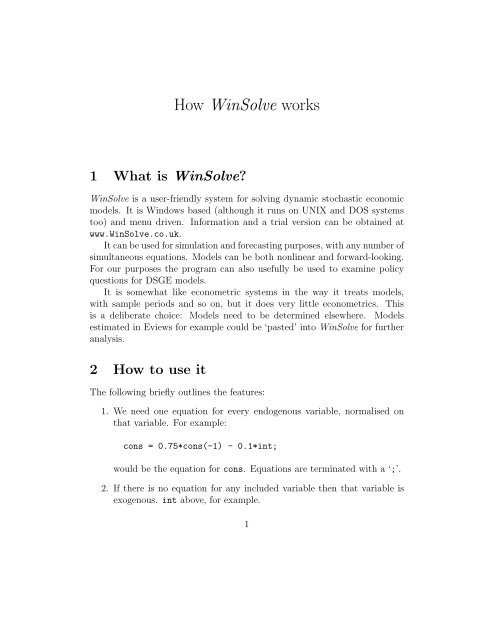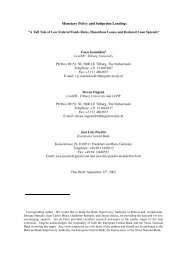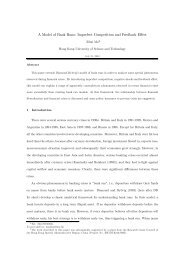Building & simulating economic models in Winsolve
Building & simulating economic models in Winsolve
Building & simulating economic models in Winsolve
Create successful ePaper yourself
Turn your PDF publications into a flip-book with our unique Google optimized e-Paper software.
1 What is W<strong>in</strong>Solve?<br />
How W<strong>in</strong>Solve works<br />
W<strong>in</strong>Solve is a user-friendly system for solv<strong>in</strong>g dynamic stochastic <strong>economic</strong><br />
<strong>models</strong>. It is W<strong>in</strong>dows based (although it runs on UNIX and DOS systems<br />
too) and menu driven. Information and a trial version can be obta<strong>in</strong>ed at<br />
www.W<strong>in</strong>Solve.co.uk.<br />
It can be used for simulation and forecast<strong>in</strong>g purposes, with any number of<br />
simultaneous equations. Models can be both nonl<strong>in</strong>ear and forward-look<strong>in</strong>g.<br />
For our purposes the program can also usefully be used to exam<strong>in</strong>e policy<br />
questions for DSGE <strong>models</strong>.<br />
It is somewhat like econometric systems <strong>in</strong> the way it treats <strong>models</strong>,<br />
with sample periods and so on, but it does very little econometrics. This<br />
is a deliberate choice: Models need to be determ<strong>in</strong>ed elsewhere. Models<br />
estimated <strong>in</strong> Eviews for example could be ‘pasted’ <strong>in</strong>to W<strong>in</strong>Solve for further<br />
analysis.<br />
2 How to use it<br />
The follow<strong>in</strong>g briefly outl<strong>in</strong>es the features:<br />
1. We need one equation for every endogenous variable, normalised on<br />
that variable. For example:<br />
cons = 0.75*cons(-1) - 0.1*<strong>in</strong>t;<br />
would be the equation for cons. Equations are term<strong>in</strong>ated with a ‘;’.<br />
2. If there is no equation for any <strong>in</strong>cluded variable then that variable is<br />
exogenous. <strong>in</strong>t above, for example.<br />
1
3. if a l<strong>in</strong>e starts with *p then what follows is treated as a parameter<br />
rather than a time series of a variable. This is very useful for sett<strong>in</strong>g<br />
up <strong>models</strong> with complicated parameter restrictions.<br />
4. Equations are described <strong>in</strong> a natural language, i.e.:<br />
*p rho = 4;<br />
x = 0.5*x(-1) + 0.5*x(+1) + rho*u/4;<br />
u = 0.1*u(-1);<br />
This example <strong>in</strong>cludes a forward look<strong>in</strong>g variable.<br />
5. Every model needs data. W<strong>in</strong>Solve supports a wide variety of data<br />
formats, read<strong>in</strong>g spreadsheets, econometric packages and raw data files.<br />
6. If the model is l<strong>in</strong>ear, then the data can be arbitrarily set to 0.<br />
7. A variety of sophisticated solution methods are available, <strong>in</strong>clud<strong>in</strong>g<br />
rational expectations and stochastic simulation.<br />
8. All equations have ‘adjustments’, analogous to residuals. These are<br />
used to shock an equation, as <strong>in</strong> an impulse response, but are much<br />
more general. They can be multiplicative or additive. For example:<br />
*m x = 0.5*x(-1);<br />
then a shock of 0.73 would imply xt =(0.5xt−1) × 1.73 for the period<br />
that it was set. Similarly:<br />
*a x = 0.5*x(-1);<br />
then a shock of 0.73 would imply xt =0.5xt−1 +0.73.<br />
The set types are used <strong>in</strong> stochastic simulation.<br />
9. Control problems can be solved by specify<strong>in</strong>g an <strong>in</strong>strument and an<br />
objective function.<br />
10. W<strong>in</strong>Solve can now do control problems assum<strong>in</strong>g a l<strong>in</strong>ear (or l<strong>in</strong>earised)<br />
model and a quadratic objective, <strong>in</strong>clud<strong>in</strong>g time <strong>in</strong>consistent and time<br />
consistent control.<br />
2








